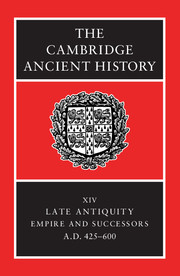Book contents
- Frontmatter
- PART I CHRONOLOGICAL OVERVIEW
- PART II GOVERNMENT AND INSTITUTIONS
- PART III EAST AND WEST: ECONOMY AND SOCIETY
- 12 Land, labour and settlement
- 13 Specialized production and exchange
- 14 The family in the late Roman world
- 15 Family and friendship in the west
- 16 State, lordship and community in the west (c. A.D. 400–600)
- 17 Armies and society in the later Roman world
- PART IV THE PROVINCES AND THE NON-ROMAN WORLD
- PART V RELIGION AND CULTURE
- Conclusion
- Chronological Table
- BIBLIOGRAPHY
- Index
- References
14 - The family in the late Roman world
from PART III - EAST AND WEST: ECONOMY AND SOCIETY
Published online by Cambridge University Press: 28 March 2008
- Frontmatter
- PART I CHRONOLOGICAL OVERVIEW
- PART II GOVERNMENT AND INSTITUTIONS
- PART III EAST AND WEST: ECONOMY AND SOCIETY
- 12 Land, labour and settlement
- 13 Specialized production and exchange
- 14 The family in the late Roman world
- 15 Family and friendship in the west
- 16 State, lordship and community in the west (c. A.D. 400–600)
- 17 Armies and society in the later Roman world
- PART IV THE PROVINCES AND THE NON-ROMAN WORLD
- PART V RELIGION AND CULTURE
- Conclusion
- Chronological Table
- BIBLIOGRAPHY
- Index
- References
Summary
CHRISTIANITY AND LAWS ON THE FAMILY
Before Constantine, no Roman emperor, not even Augustus, had displayed such a strong ambition to reshape family legislation and initiate thereby an extensive project of moral reconstruction: pudor tutus, munita coniugia was how a panegyrist pithily expressed it as early as 321. In some respects, Constantinian legislation merely brought to completion tendencies that had been operative for some time; in others, it was more innovative. On the whole, it aimed at asserting principles of rigour, order and temperance in family relationships. Often it revealed a somewhat darker side, betraying both acute perception and ill-concealed pessimism, and alongside the wishful imperatives we also find realistic laws concerning concrete situations. The frequency and variety of these measures testify to the importance of political policy on these issues.
Constantine’s laws had three principal aims, all closely interlinked: to safeguard celibacy, to encourage the matrimonium iustum and to protect infants and minors. The first was accomplished by repealing the Augustan marriage laws, which had penalized celibates and childless couples (by restricting their ability to receive inheritances and legacies) and provided incentives to matrimony and procreation. A variety of measures contributed towards achieving the second aim: socially mixed unions and concubinage were repressed; greater significance was attributed to the promise of marriage; abduction was severely punished; accusations of adultery could no longer be made by outsiders, but only by the husband or by the wife’s close male relatives; adultery was punished by death.
- Type
- Chapter
- Information
- The Cambridge Ancient History , pp. 392 - 415Publisher: Cambridge University PressPrint publication year: 2001
References
- 3
- Cited by

